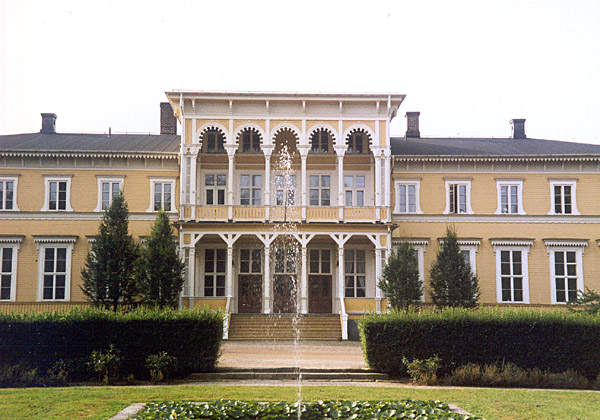| Ramlösa brunn

| | Ramlösa Brunn blev indviet allerede i 1707, men havde sin blomstringstid i 1800-tallet. Det helbredende vand og de kongelige interesser lokkede mange besøgende til brøndhotellet, og ved slutningen af 1800-tallet opførtes denne prangende hovedbygning i skønvirkestil. |
Det hellige vand
På den skånske side blev Ramlösa et centrum for brønd- og badekure. I begyndelsen var det selve vanddrikningen som var det centrale. Vand har altid været anset for at være rensende og livgivende. Dette er ikke spor ejendommeligt, da vand er naturens livsnerve. I antikkens tid erklærede man at visse kilder havde en guddommelig kraft og vandet fra dem blev betragtet som helligt. I Pergamon f.eks., fandtes den hellige brønd ved templet. For Asklepios, som var lægekunstens gud og derfor anså man vandet ved hans tempel for medicinsk virkningsfuldt.
Kristendommen tog denne tanke til sig og mange helgener forbindes tit med forskellige kilder, hvor man drak vandet eller ofrede f.eks. mønter i de hellige brønde. Efter reformationen blev denne kildekult modarbejdet af protestantiske præster, men i 1600-tallet begyndte man at interessere sig for disse hellige kilders virkemåde, set fra en videnskabelig synsvinkel.
I Sverige gennemførtes vandanalyser af Urban Hjärne, og mange læger tilskrev visse brønde og kilder helsefremmende egenskaber. Kildekulten fik derved en renæssance i 1700-tallet. Men vandet var ikke kun til indvortes brug. Afvaskning og bad ansås også for helsefremmende og på kurstederne indrettedes derfor badeanstalter. I 1700- og 1800-tallene rejste mange til Spa, Aachen, Schwallbach og andre kursteder for at forbedre deres helbred gennem brønddrikning og bade. Da nogle læger begyndte at tale for saltvandets gode og helsebringende egenskaber, fik de kursteder som lå ved havet et særligt opsving.
Ramlösas start
Ramlösa Brønd indviedes allerede i 1707. Da havde man i flere decennier talt om, at kilden i Ramlösa gav sundhed og kraft. Desuden havde lægen Johan Jacob Döbelius betonet kildens helsebringende virkning. Man mente at Ramlösavandets indhold af jernkarbonat kunne kurere reumatisme, nyresten, iskias, hjertelidelser m.v. Allerede i løbet af 1700-tallet besøgtes Ramlösa af tidens etablissement, men det var først i 1800-tallets første halvdel at Ramlösa fik sin egentlige storhedstid.
Perioden med professoren i medicin ved universitetet i Lund, Eberhard Munck af Rosenschiöld, som brøndlæge, blev særlig betydningsfuld. Han var en af tidens store lægeautoriteter, og Ramlösa fik derved en særstilling, eftersom helsebrønden nu fik en videnskabelig tilknytning. Rosenschiöld propaganderede også for salte bade og Ramlösa blev derfor et kursted, hvor man både drak brøndvand og badede i havvand.

Jernvandskilden | 
Johan Jacob Döbelius | 
Munck af Rosenschiöld |
Royale gæster
Ramlösa brønd var omgivet af et kongeligt skær. Gustav IV Adolf besøgte ofte brønden under et tre måneder langt ophold i Helsingborg i 1807. Kronprinsen, Karl August, var i Ramlösa i maj 1810. Karl 14. Johan opholdt sig der flere somre og indskød penge i sygehusbyggeriet i parken. Virksomheden ved sygehuset blev med tiden temmelig omfattende, og ved slutningen af århundredet kunne man tage imod 160 patienter. Karls søn, Oscar (Oscar I), som ofte var syg, besøgte Ramlösa flere gange i 1810- og 1820-tallene, ikke mindst fordi brøndlægen hed Munck af Rosenschiöld.
Oscars mor, dronning Desideria, opholdt sig i Ramlösa flere somre og trivedes usædvanlig godt. Hun klagede ellers tit over forholdene i sit nye hjemland. Måske savnede hun sin tidligere kæreste, Napoleon Bonaparte, og det skær som omgav ham? De kongeliges tilstedeværelse tiltrak besøgende fra de højere klasser, og Ramlösa blev et tilholdssted for overklassen. En mondæn omgangsform udvikledes, med kongefamilien i centrum. Mange adelige familier byggede deres egne boliger i parken, som blev præget af træarkitektur i nyromantik og nyklassicisme.

Kongelige gæster | 
Sygehuset |
Anlægget vokser
En hestetrukken sporvognslinie, den første i Sverige, blev anlagt ned til havet i 1877, så at gæsterne bekvemt kunne transporteres til badet. Man havde en omfattende køreplan med hyppige ture. Om formiddagen hvert kvarter og om eftermiddagen hver halve time. Man byggede et badehus ved sundet, og på stranden voksede en hel forlystelsespark op, med skydebane, restaurant og musikpavillon. Ramlösa befæstede sin stilling som badested, og dette tydeliggjordes endnu mere, med de badeanlæg man byggede ved selve kurhotellet.
Ved slutningen af 1800-tallet ændrede Ramlösa Brønd karakter, og udvikledes i retning af et almindeligt rekreationsanlæg med afkobling og forlystelser. På den tid fandt man også den alkaliske kilde, som i dag udgør indholdet i ”Ramlösa Mineralvand”.

Kurhotellet | 
Den første hestesporvogn | 
Badeanlægget | 
Arkitektur |
|